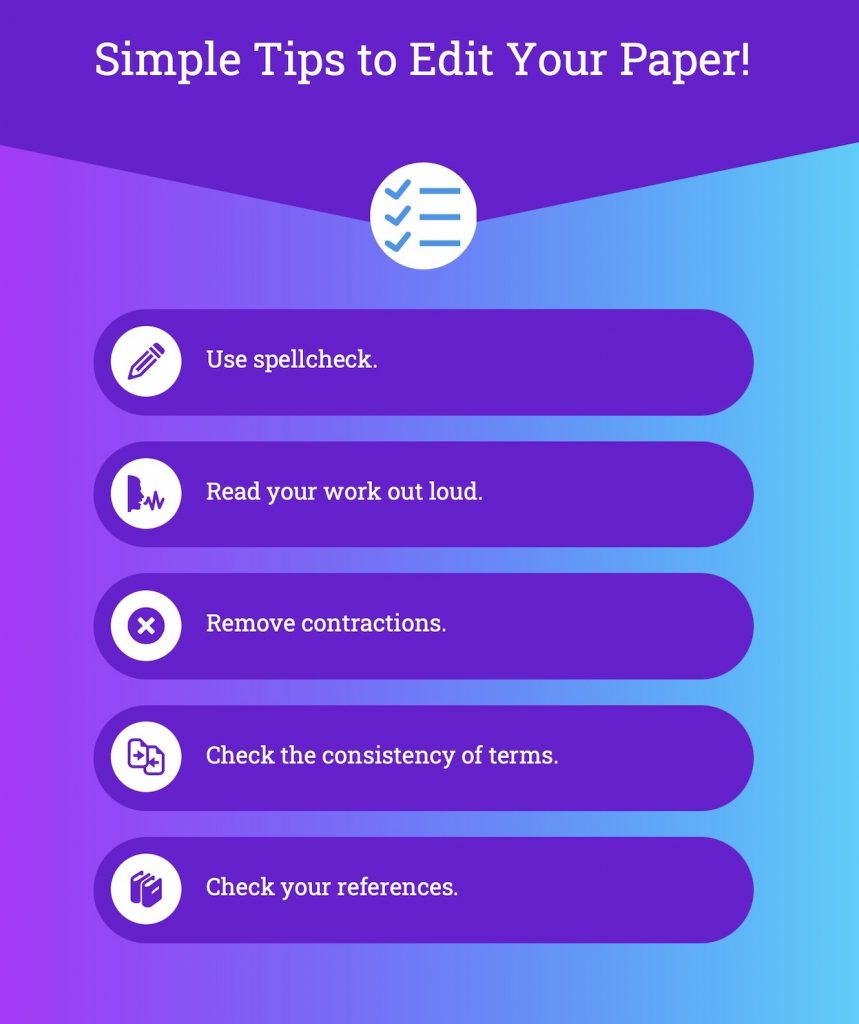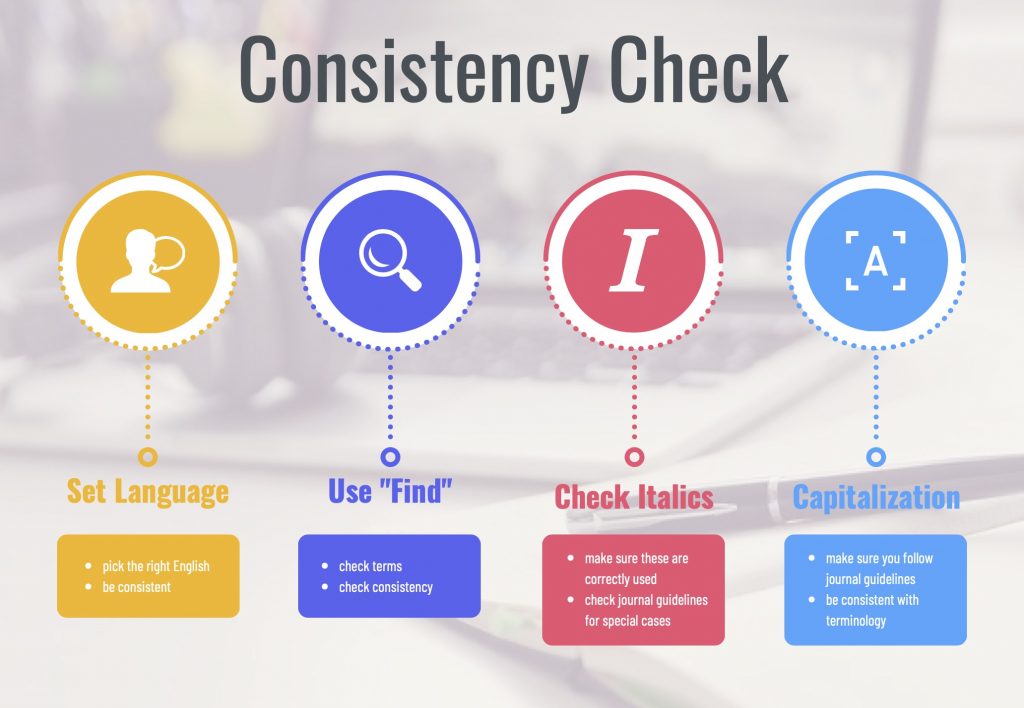
Manuscript Editing Tips (5 Ways to Improve Your Work)
Manuscript editing tips can be too complicated or unclear. Many authors just want to know “what is the easiest way for me to edit my work?” because proofreading and editing are very important for academic manuscripts. This article goes over five straightforward practices to help you improve any manuscript you write.
- Start by using spellcheck.
- Read your work out loud.
- Remove all contractions.
- Make sure your terms are consistent.
- Double check your references.
Speed is important for academic work and authors often want their research published as soon as possible. Spending a couple of days checking your work can save weeks during the publication process. How? Imagine sending your work for peer-review, but it gets rejected because of the English! It’s important to spend time checking your paper first to save time later.

Simple manuscript editing tips for your work.
Use spellcheck to find basic errors
One of the easiest tips to improve your manuscript is to use spellcheck. It’s free and easy to use. If you’re using Microsoft Word on Windows, press “Alt + F7”, and if you’re using a Mac, press “Option + Command + L”. It’s that easy! It’s important to remember a couple of things when you use it though:
- Don’t click “Change All”. Check every edit, one by one, to make sure that it is correct.
- The dictionary in Word might not have specialized words. If you see a word that you know is correct, you should add it to the dictionary to help Word moving forward.
- Always double check changes after you’ve made them. Sometimes mistakes happen when applying a change, so always double check.
Read your work out loud
Without question, this is the best advice we can offer for editing your manuscript. Make yourself a cup of coffee or tea (or whatever drink you prefer) and take some time to read your work aloud. Say each word out loud; if you have trouble understanding what you wrote, you should fix that section of text. When you read out loud your brain can’t fill in the blanks in your text. You will hear when things are missing. This also helps you to spot words that appear twice (for example, “the the” is a very common error). Here are a few other common issues:
- There might be missing punctuation.
- Some terms might be inconsistent; for example, et. al., et al, et al.
- There might be periods before references. It’s important to catch these errors, but this depends on the style guide (more on references below).
Here are a couple of other benefits from this handy tip:
- Reading your work can help you to find sections that might appear twice.
- Sometimes copy and paste is doubled and missed.
- There might also be sections of text that need to be moved to another part of the manuscript for clarity.
Pro tip: Change the font size to trick your brain into thinking it’s a new document. This simple idea can help you to more easily edit your manuscript!
Replace contractions with the spelled-out words
Academic writing is formal writing. When you are editing your work, remember to change any contractions you find. “Can’t” becomes “cannot”, “don’t” becomes “do not”, and so on. We cover some specific manuscript editing tips in a bit more detail in an article explaining some MDPI-specific edits. Finding these examples is pretty easy. Use the “Find” function in Word to look for the contractions and replace them with the full words.
- ’t
- ’re
- ’ll
- ’s*
* When you’re replacing ’s, make sure that you’re only removing it from contractions and not in cases where it is correctly used. Some possessives use ’s as well and it’s correct!
For example, “Marco’s dog” is correct.
Take your time to make sure that you make the correct edits here, as a little time here can save you a lot of time later.
Make sure that terms in your manuscript are consistent
Is it BAX or bax or bax?
Should it be mRNA or miRNA?
Do I use analyse or analyze?
Consistency is a broad idea. It covers many different topics, ranging from formatting to what English you use (American, British, Canadian, etc.). To make sure that your work is consistent, it’s best to develop a handful of editing practices. To help you with this, we’ve included a list of four handy editing tips that you can apply to your work. These won’t fix all the issues, but they will address some common problems.
Simple steps
Remember that if you’re ever unsure about how to edit your own work, sometimes it helps to have someone look at it. We’ve put together a simple guide to understand how to pick editing services if you’re in the market for one.
- Set the language of your paper: Make sure that you pick English as the language setting in Word. This will help the program to find inconsistencies like “analyse” and “analyze”. With a click of your mouse, you can fix these issues.
- Use “Find” to check important terms: Sometimes a term will be capitalized and not capitalized (sometimes in the same paragraph!). A paper might use “Scanning Electron Microscope” and “scanning electron microscope”. Pick one and make any changes you need to make the terms consistent.
- Italics: These can be tricky to use, but they can be very important. For example, APOE refers to a gene, but APOE is a protein. It can be extremely important to the meaning of your work to spend a few extra minutes making sure that you are using italics correctly. Italics is a big topic and there are many different ways that they can be used. We cover a number of the different ways they are used in another article.
- Capitalization: As we noted above, sometimes capitalization is inconsistent. One area to keep an eye on is journal-specific capitalization. Does your journal use “figure 1” or “Figure 1”? Make sure that these are correct and consistent and it will help your paper to shine.

Four simple manuscript editing tips to improve the consistency of your paper.
Pointers
There are many situations where terms can be similar but mean different things. mRNA and miRNA are different things, so making sure that your terms are clear and consistent is very important. Take a moment to go over your terms, one by one, to make sure they are correct. In the same way that you used the “Find” function to look for contractions, you can do the same with consistency.
Are you using the same font, the same font size? Are the figures and tables using the same format? Does your manuscript have a supplementary file (or files)? Are you applying consistency there as well?
Pro tip: Make sure you check all your figures and use a higher-resolution image when necessary. It’s important for figures to be clear and easy to read!
Double-check your references
Lots of programs can help you to organize your references, but it is always a really good idea to make sure that your references match up correctly and that you’re using the right name. Sometimes we might add a reference (or take one out) and this affects the order of your entire references section. Make sure that these are all in order.
- What style does the journal use? ACS, Chicago, and so on.
- Are they all in order?
- Are they all referenced in the same way?
- Do they match properly in the references section?
There are also other kinds of referencing that happen in academic work. For example, are all references to figures and tables (and supplementary files) in the text correct and consistent? This is also an important point to remember to check. Using the points above, one by one, check the format of the style guide and verify that all the references are correctly in order. Then, make sure that you aren’t mixing the references. Using both numbered references (e.g., [1,2,5]) and names (such as Smith et al.) isn’t correct, you’ll want to use only one style! Finally, make sure that the references section and the numbers in the text match up properly.
There are lots of programs that you can use to do this work, but it is very important to check for yourself! To learn more about the importance of proper referencing, I created a handy guide for you to review.
Further reading
Here on the MDPI Blog, we regularly publish articles designed to help you make your writing the best it can be. Here are three examples for you to start with.
How To Improve Your Academic Writing Style features three tips that can help make your writing more precise and ensure your voice is original. These include varying your sentence structure, mixing up your punctuation, and using transition words and sentence openers. Each tip is also supported by detailed information on how to start making these changes.
Why Grammar Is Important In Academic Communication outlines how grammar is the cornerstone of good communication. It focuses on boosting clarity, influencing the reader’s perception of your work, and also ensuring it is accessible to readers.
Finally, and similarly, 3 Grammar and Punctuation Errors To Avoid explores how you can improve your grammar with specific examples and tips on how. These include preventing sentence fragments and comma splices from occurring and using apostrophes correctly.
Let us edit your manuscript

With these helpful tips for editing your manuscript, you can fix some basic errors that show up often in a lot of works. Academic editing can be tricky sometimes, and it always pays off to have a professional look at your work. If you’re still not sure, don’t have time, or want a pro to look at your work, let our skilled English Editors help. Visit MDPI Author Services now for a free estimate for fast, accurate, and professional editing.










